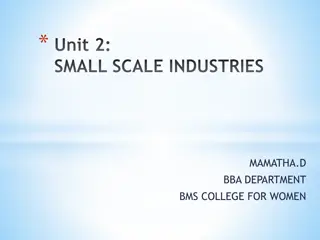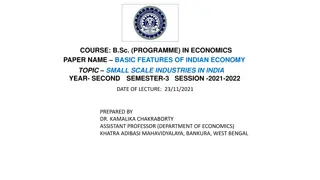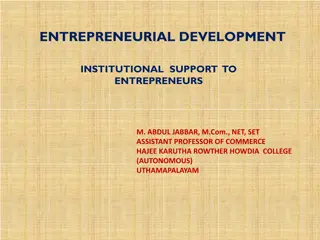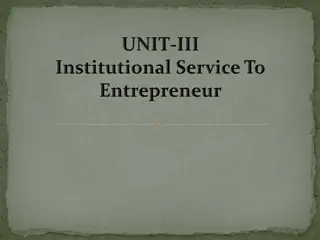
Small Scale Industries in India: Key Characteristics and Challenges
Small Scale Industries (SSIs) in India play a significant role in the country's economy, contributing to exports, GDP, and employment. This sector faces challenges in the era of liberalization and economic reforms, necessitating competitive strengths, technology upgrading, and efficient resource management.
Download Presentation

Please find below an Image/Link to download the presentation.
The content on the website is provided AS IS for your information and personal use only. It may not be sold, licensed, or shared on other websites without obtaining consent from the author. If you encounter any issues during the download, it is possible that the publisher has removed the file from their server.
You are allowed to download the files provided on this website for personal or commercial use, subject to the condition that they are used lawfully. All files are the property of their respective owners.
The content on the website is provided AS IS for your information and personal use only. It may not be sold, licensed, or shared on other websites without obtaining consent from the author.
E N D
Presentation Transcript
Small Scale Industries in India Prof. Alok Kumar Goyal Department of Economics Deen Dayal Upadhyay Gorakhpur University
Small Scale Industries (SSIs) This Sector accounts for about 40% of the Country s Total Exports, 8% of GDP, 40% of manufacturing output and 80 % of Manufacturing employment. Various Policy Initiatives undertaken by the Central Govt & State Govts whether by way of Incentives or protection, have helped the sector in acquiring the Status of a Major Contributor in the Growth Process. The Process of Liberalization & Economic Reforms, since 1991, while creating Tremendous Opportunities for the Growth of Small Scale Industrial Sector, have however thrown up new Challenges for the Sector. This changed Industrial Scenario, has called for building Competitive Strengths, Improving Quality & Productivity, Introducing Technology Up gradation, reducing Wastages & Rejections, Intelligent Use of Resources, Employing Modern Management Techniques etc in order to withstand growing competition & for ensuring sustained growth.
SSIs Components The SSI sector covers a wide spectrum of industries categories under: (a) Small scale industries undertakings (b) Ancillaries industrial undertakings (c) Tiny enterprises (d) Export oriented units (e)Small scale services enterprises (f) Artisans, village & cottage industries (g) Small scale unit where one or more women entrepreneurs have not less than 51% financial holding
Characteristics of Small Enterprises : According to Shumakharan: Small Enterprise is Beautiful because of its following Important Characteristics : 1) A Small Enterprise is generally a One Man Show . Even Small Enterprises which run by a Partnership Firm or a Private Limited Company, in most cases, the activities are mainly carried out by one of the Partners or Directors. In Practice, the others mainly assist in providing Capital / Funds. .
Contd 2) Owner himself / herself is also a Manager of the Enterprise. Thus, a Small Enterprise is managed in a personalized manner. The Owner has First Hand Knowledge of all aspects of the Enterprise & knows what is actually going on in the Business. He takes effective participation in all matters of Business Decision Making. 3) A Small Enterprise has lesser Gestation Period compared to a Large Enterprise. i.e., the period after which the return on Investment starts. Over.
Contd 4) Small Enterprises generally carryout their operations so as to cater to the Local & Regional Markets. 5) Small Enterprises use indigenous resources & therefore can be located anywhere subject to the availability of these resources like Raw Materials, Labor, Transport Facilities etc. 6) They are fairly Labor Intensive with comparatively smaller Capital Investment than the Larger Units. That is, for the same Investment, a Small Enterprise provides more jobs to the people compared to a Large Enterprise.
Contd 7) Using Local Resources, Small Units are decentralized & dispersed to Rural Areas & Smaller Towns. Thus, the development of Small Enterprises in Rural Areas & Smaller towns promotes more Balanced Regional Development & thereby prevents influx of job seekers from rural areas & smaller towns to bigger cities & urbanizing centers. 8) Small Enterprises are more susceptible & highly reactive & receptive to Socio Economic conditions compared to larger enterprises. They are more flexible to adapt changes like Diversification to New Products, adopting to New Production Techniques, substituting New Raw Materials, Changes in rganization Structure, New Market etc. .
Concepts & Definitions of Small Scale Industrymy It Comprises a Variety of Undertakings. These definitions generally relate to either the Capital Invested or people employed or both or any other relevant criteria Annual Turnover. on the Basis of Investment SSI have been classified broadly into Two Categories Under Micro, Small and Medium Enterprise Development (MSMED )ACT-2006:
:MSMED ACT-2006: 1) Manufacturing Enterprises : Enterprises which are engaged in the Manufacture / Production of Goods pertaining to any Industry are referred to as Manufacturing Enterprises Enterprises Investment in plant & machinery Micro Enterprises upto Rs. 25 Lakh Small Enterprises 25 Lakh & upto Rs. 5 Crore Medium Enterprises Rs. 5 Crore & upto Rs. 10 Crore .
II) Service Enterpris: They have been defined in terms of their Investment in Equipment (excluding Land & Building) & further classified into 3 Categories as under : Enterprise Investment in plant & machinery Micro Enterprises upto Rs. 10 Lakh Small Enterprises 10 Lakh & upto Rs. 2 Crore Medium Enterprises Rs. 2 Crore & upto Rs. 5 Crore
In 2018, SSI classified on the basis of Annual Turnover Enterprise Turnover Micro Enterprises upto Rs. 5 Crore Small Enterprises 5 crore & upto Rs. 75 crore Medium Enterprises Rs. 75 Crore & upto Rs. 250 Crore
Advantages of Small Enterprises : They are the Back Bone of the Industrial Activity in the Country & are playing a very important role in improving the Socio Economic Conditions of the people. Advantages of these Enterprises are as follows : 1) They create greater Employment Opportunities thro Labor Intensive processes & thereby help in tackling the Unemployment Problem.
Contd 2) They have Low Gestation Period & thereby Expensive Financial Resources are not idled unproductively for long periods. 3) They can be set up easily in Rural & Backward Areas. 4) They need Small / Local / Regional Market. 5) They encourage growth of Local Entrepreneurship. 6) They create Decentralized pattern of Ownership. 7) They foster Diversification of Economic Activities. .
Contd 8) They Innovate & Introduce New Products particularly to cater to Local Needs. 9) They influence & improve Standard of Living of Local People. 10) They provide equitable dispersal of enterprises throughout Rural & Backward Areas. 11) They earn Vital Foreign Exchange for the Country through their Exports of Goods / Services. 12) They Increase Revenue to Central & State Govts by way of Taxes Paid by them.
Need & Rationale of Small Scale Industry Development in India : As per the IPR (Industrial Policy Resolution),1956, it emphasizes the Need & Rationale as given below : They provide immediate large scale employment, they offer a method of ensuring a more equitable distribution of the National Income & they facilitate an Effective Mobilization of Resources of Capital & Skill which might otherwise remain unutilized. Some of the problems that unplanned urbanization tends to create will be avoided by the establishment of Small Centers of Industrial Production all over the Country.
1) Employment Argument : In View of the Scarce Capital Resources of the Country & large Manpower, the most important argument put forth in favor of the SSI s is that they have a potential to create immediate large scale employment opportunities. The increasing emphasis on SSI s originates from the widespread concern over the Unemployment Situation in the Country. It has been found that Small Scale Units are more Labor Intensive than Larger Units. i.e., Small Units use more labor per Unit of Output than the Investment. .
Contd It has also been found by various studies that while Output Employment Ratio (Ratio of Output to the No. of people employed) is the lowest in the Small Scale Sector, the Employment Generation Capacity of Small Sector is between 8 to 15 times that of the Large Sector for the same amount of Capital Invested for different types of Industries. However, some Scholars have opposed this employment argument of Small Scale Industries. They argued that Employment should not be created for the sake of employment. The more important problem being, how to make the best use of the Scarce Resources like Capital, Power, Raw Materials, etc, & not how to absorb Surplus Resources (Manpower). Then, the Employment Argument becomes an.
2) Equality Argument : Another Argument put forward in favor of the Small Scale Industry is that they ensure a more Equitable Distribution of National Income & Wealth. There are 2 Major Considerations : 1) The Ownership Pattern of SSI s is more widespread compared to the Ownership of Large Scale Units in which Major Stake Holders are only a few. 2) They are more Labor Intensive & their Decentralization & Dispersal to Rural & Backward Areas provide more Employment Opportunities to the Unemployed. This results in more equitable distribution of the produce of the Small Scale Units. Here, since it is Proprietorship or Partnership, the relations between the Labor & Management are more harmonious & cordial in Small Enterprises than in Large Enterprises.
Contd.. Some Authors argued that such Small Enterprises paid less to the Workers, may be only Half of the Wages paid to Workers of Large Enterprises. This is because Workers in Small Enterprises are Unorganized due to absence of Trade Unions & therefore easily exploited by Employers. But, However, the Workers choice is really not between a High Paid Job & a Low Paid One, but between a Low Paid Job or No Job at all. Thus we can say the SSI s have great importance in an Economy like Ours where millions are unemployed & in search of a Livelihood.
3) Decentralization Argument : This stresses the need to disperse the Industrial Development to different regions so as to promote Balanced Regional Development in the Country. Large Industries are concentrated everywhere in Urban Areas. But, Small Enterprises can be located in Rural & Semi Urban Areas to use Local Resources & to meet Local Demands. Decentralization of Industrial Enterprises will help harnessing Local Resources such as Raw Materials , Idle Capital , Local Talents , & ultimately improves the Socio Economic Conditions & the Standard of Living of the People even in the erstwhile backward areas.
Latent Resources Argument : This Argument suggests that Small Enterprises are capable of picking up Latent & Unutilized Resources like hoarded Wealth, & Idle Entrepreneurial Ability. However, the Real Force of Latent Resources Argument lies in the existence of Entrepreneurial Skill. The impressive growth in the number of small enterprises during the last six decades highlights the same fact that providing the necessary conditions such as Land, Sheds, Power, Good Transport & Communication Facilities , Credit Facilities etc, the Latent Resources of Entrepreneurship can be tapped by the Growth of Small Scale Industries only.
Objectives of Developing Small Enterprises : Reasons for Developing Small Enterprises in India can be enumerated as follows : 1) To generate Large Scale Employment Opportunities for the Unemployed speedily with relatively Low Investment. 2) To Eradicate Unemployment Problem from the Country. 3) To encourage dispersal of enterprises to all over the country covering Rural Areas , smaller towns & economically backward regions. 4) To bring Backward Regions too in the mainstream of national development.
Contd 5) To promote balanced regional development in the Whole Country. 6) To ensure more equitable distribution of National Wealth & Income. To encourage effective mobilization of Untapped Resources of the Country. To improve Socio Economic Conditions & Standard ofLiving of the people in the Country. To seize the Vast Opportunities created for Small Enterprises due to Liberalization & Globalization policies of the Govt of India. 10) To help earn Vital Foreign Exchange for the Country thro Exports of Goods / Services of Small Enterprises. 11) To bring more Revenue to the Central & State Govts by way of Taxes. 7) 8) 9)
Role of Small Enterprises in Economic Development Increase in the Number of Small Enterprises. In 1950, there were 16,000 Registered Small Scale Industries & this has increased to 633.8 Lakh Registered & non registered SSI s during 2015-16. Increase in the Value of Production in Rupee Terms. Production During 1973 74, the Total Value of Production reported by SSI s was Rs. 7200 Crores & this has grown phenomenally by about 75 Times to Rs. 5,38,357 Crores during 1998 1999. SSI s production was 45% of total manufacturing out during 2005-06 1) 2) 3) Increase in the Number of People Employed. Increase in the Export Earnings in Rupee Terms. Employment As regards Employment, about 40 Lakh People were employed in SSI Sector during 1973 1974 & there is a Four Fold Increase in Employment during 1998 1999, and 6 crore People were employed in SSI Sector during 2005-06,.10 crore people were employed in registered & non registered SSI sector during 2015-16. 4) .
Contd There is a Phenomenal Growth in Exports Revenue during the last Four Decades. During 1973 -1974, SSI Sector exported Rs. 393 Crores worth of Goods & Services & this has grown nearly 150 times to Rs. 57, 488 Crores during 1998 - 1999 . As we can see, the SSI Sector has been contributing tremendously in overall economic development of the Country by creating Vast Employment Opportunities , increased Value of Production, & increased Value of Exports & Foreign Exchange Earnings. Another way of looking at the SSI Sector for the Economic Development of the Country is to look at its Relative Position in terms of Country s Total Production, Employment & Exports. It is encouraging to note that Small Scale Enterprises accounts for 45 % of the Gross Value of the Output in the Manufacturing Sector , about 80 % of the Total Industrial Employment & about 40 % of the Total Exports of the Country.
Government Policy towards SSI : Small Scale Enterprises have been given an important place in the frame work of Indian Planning for both ideological & Economic Reasons. Development of Small Scale Enterprises have been taken up with various important objectives to be realized. These are : (1) The generation of Immediate Employment Opportunities with relatively Low Investment. (2) The promotion of more equitable distribution of National Income. (3) Effective mobilization of untapped Capital & Human Skills. (4) Dispersal of Manufacturing activities all over the Country, leading to growth of Villages , Small Towns & economically Backward Regions.
Contd Therefore, the Govt of India as well as various State Govts in the Country have started various programs & evolved policies for the Development of Micro & Small Enterprises in the Country. Various measures taken by the Central & State Govts for the development of Micro & Small Enterprises have included Product Reservations, subsidies on fixed capital investment, Sales Tax & Income Tax Concessions, Preferential allocation of credit & interest subsidy, extension of business & Govt purchases, Marketing Assistance including Export Promotion by institutions such as National Small Industries Corporation, Small Industries Development Organization & several other agencies.
Supporting Institutions /Agencies of Govt for Small Enterprises : Need for Institutional Support : Small Enterprises are playing a Very Vital Role in Economic Development of the Country by contributing to increased Production, increased employment generation, contributing to nearly 40 % of our Country s Exports thereby help earning Important Foreign Exchange for the Country & finally giving substantial revenue to both Central & State Govts by way of Direct & Indirect Taxes. Therefore, Small Scale Enterprises Sector needs a lot of support & encouragement for its rapid growth from both Central & State Govts. Setting up of Small Enterprise requires Infrastructural Facilities & Financial Support as Entrepreneur on his own cannot arrange all these requirements. Entrepreneur also requires support for marketing his Product (s) / Service (s) , he requires Technological Inputs & also ED Training, therefore, a strong Governmental Institutional Network is required.
Policy towards SSI A: Policy prior to 1991 B: New Small Enterprise Policy 1991 C: Comprehensive Policy Package 2000 and Recent Policy Measures
Policy towards SSI A: Policy prior to 1991 A large number of steps were initiated by Govt. These included the building up of organisational structure, increase in the plan expenditure, reservation & financial assistance for SSIs, setting up of SIDBI and other measures. B: New Small Enterprise Policy 1991 - Important measures were announced as like- increase the investment limit for SSIs, Equity participation Strengthen Existing Technological Facilities. It is formulating a Scheme of assistance for Technology Up gradation. In order to facilitate adequate flow of Credit, a scheme of Credit Guarantee has been launched. Measures have been taken to improve Infrastructure Facilities & Promote Marketing of Products etc.
Contd C: Comprehensive Policy Package 2000 and Recent Policy Measures The main elements of the package were: 1. conducting the third census of SSIs 2.raising exemption for excise duty limit, 3. providing credit linked capital subsidy, 4. raising the investment limit in 2000 & MSMED -2006 of SSIs. 5.raising the composite loan limit,etc Recent Policy Measures: dereservation policy of SSIs, Pradhan Mantri Mudra Yojana, National Manufacturing Competitiveness Programme(NMCP), Udyog Aadhar Memorandum (UAM),ASPRIRE ( A scheme for promoting innovation and rural entrepreneurs) , ZED scheme (Zero effect and Zero defect ), etc.
The Governmental Institutional Support a) Central Level Institutions / Agencies. b) State Level Institutions / Agencies.
Central Level Support Institutions /Agencies : 1) under the Central Ministry of Micro, Small & Medium Enterprises in which Ministry of Agro & Rural Industries has also been merged. 2) National Board for Micro, Small & Medium Enterprises (NBMSME). 3) Small Industries Development Organization (SIDO). 4) National Small Industries Corporation (NSIC). 5) Small Industries Development Bank of India (SIDBI). 6) Khadi & Village Industries Commission (KVIC). 7) National Science & Technology Entrepreneurship Development Board (NSTEDB) 8) National Productivity Council (NPC). 9) National Institute for Small Industry Extension & Training (NISIET). 10) National Institute for Entrepreneurship & Small Business Development (NIESBUD). 11) Indian Institute of Entrepreneurship (IIE). 12) Entrepreneurship Development Institute of India (EDII). 13) National Bank for Agricultural & Rural Development (NABARD). 14) Council of Scientific & Industrial Research (CSIR). Development Commissioner, Micro, Small & Medium Enterprises (DC MSME)
State Level Support Institutions / Agencies : 1) Directorate of Industries & Commerce (DI & C). 2) District Industries Centers (DICs). 3) State Financial Corporation 4) Small Industries Development Organisation (SIDO) 5) Regional Small Industries Service Institutes (RSISI)
Problems of SSIs 1) Finance and credit 2) Infrastructural constraints 3) Problems of marketing 4) Delayed payments 5) Problems of sickness 6) Poor database of SSIs 7) Adverse effects of economic reforms and globalisation
Committees Related to SSIs 1) Aabid Hussain Committee -1997 2) Meera Seth Committee-1997 3) U K Sinha Committee-2019
References 1) V K Puri & S K Misra: Indian Economy, HPH 2) Datt & Sundharam: Indian Economy, S Chand & Compy.






















